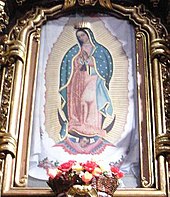Aureola

An aureola or aureole (diminutive of Latin aurea, "golden") is the radiance of luminous cloud which, in paintings of sacred personages, surrounds the whole figure.
In Romance languages, the noun Aureola is usually more related to the disc of light surrounding the head of sacred figures, which in English is called halo or nimbus. In Indian religions, the back or head halo is called prabhāmaṇḍala or prabhavali.
In art
In the earliest periods of
The aureola, when enveloping the whole
This is not to be confused with the specific motif in art of the Infant Jesus appearing to be a source of light in a Nativity scene. These depictions derive directly from the accounts given by Saint Bridget of Sweden of her visions, in which she describes seeing this.[1]
Development
The nimbus in Christian art first appeared in the 5th century, but practically the same motif was known from several centuries earlier, in pre-Christian
In the circular form the nimbus constitutes a natural and even primitive use of the idea of a
Mandorla

A mandorla is a vesica piscis shaped aureola which surrounds the figures of Christ and the Virgin Mary in traditional Christian art.[4] It is commonly used to frame the figure of Christ in Majesty in early medieval and Romanesque art, as well as Byzantine art of the same periods. The term refers to the almond like shape: "mandorla" means almond nut in Italian. In icons of the Eastern Orthodox Church, the mandorla is used to depict sacred moments which transcend time and space, such as the Resurrection, Transfiguration, and the Ascension. These mandorla will often be painted in several concentric patterns of color which grow darker as they come close to the center. This is in keeping with the church's use of Apophatic theology, as described by Dionysius the Areopagite and others. As holiness increases, there is no way to depict its brightness, except by darkness.
In a famous romanesque fresco of Christ in Glory at
The
In one special case, at Cervon (
In the symbolism of
Aureole (atmospheric phenomenon)
In meteorology, an aureole is the inner disk of a corona, an optical phenomenon produced by the diffraction of light from the Sun or the Moon (or, occasionally, other bright light sources)[10] by individual small water droplets and sometimes tiny ice crystals of a cloud or on a foggy glass surface.[11][12] The aureole is often (especially in case of the Moon) the only visible part of the corona and has the appearance of a bluish-white disk which fades to reddish-brown towards the edge.
See also
- Aura
- Aureole effect
- Crown of Immortality
- Five Crowns
- Glory
- Halo
- Heiligenschein
- Velificatio
References
- ISBN 0-85331-270-2
- JSTOR 868232.
- ^ . Encyclopædia Britannica. Vol. 2 (11th ed.). 1911. p. 924.
- ISBN 0-393-31236-4.
- ^ Conjunt iconogràfic de Sant Climent de Taüll
- ^ Image
- ISBN 0-691-07314-7.
- ^ Image
- ^ Riedel, Ingrid (1994). Hildegard von Bingen, Prophetin der kosmischen Weisheit. Kreuz Verlag, Zürich.
- ^ Cowley, Les (2012). "Jupiter corona from Iran". Atmospheric Optics. Retrieved 2016-05-02.
- ^ Calvert, J. B., The Corona, University of Denver, 2 August 2003. Access date 11 Feb. 2107
- ^ Cowley, Les, Corona, Atmospheric Optics. Access date 11 Feb. 2107
Further reading
- Timmers J.J.M. A Handbook of Romanesque Art New York London 1969 Icon Editions, Harper and Row
- Gérard de Champéaux, Dom Sébastièn Sterckx o.s.b. Symboles, introduction à la nuit des temps 3, Paris 1966 ed. Zodiaque (printed: Cum Permissu Superiorum)
- Adolphe Napoléon Didron, Christian iconography or, the history of Christian art in the Middle Ages London 1886 https://archive.org/stream/christianiconogr01didruoft
- Brian Young The Villein's Bible; stories in romanesque carving London 1990 Barry & Jenkins
- Roger Cook The Tree of Life: Image for the Cosmos New York 1974 Avon Books
- Parry, Ken; David Melling (editors) (1999). The Blackwell Dictionary of Eastern Christianity. Malden, MA.: )
External links
 Media related to Aureola at Wikimedia Commons
Media related to Aureola at Wikimedia Commons
